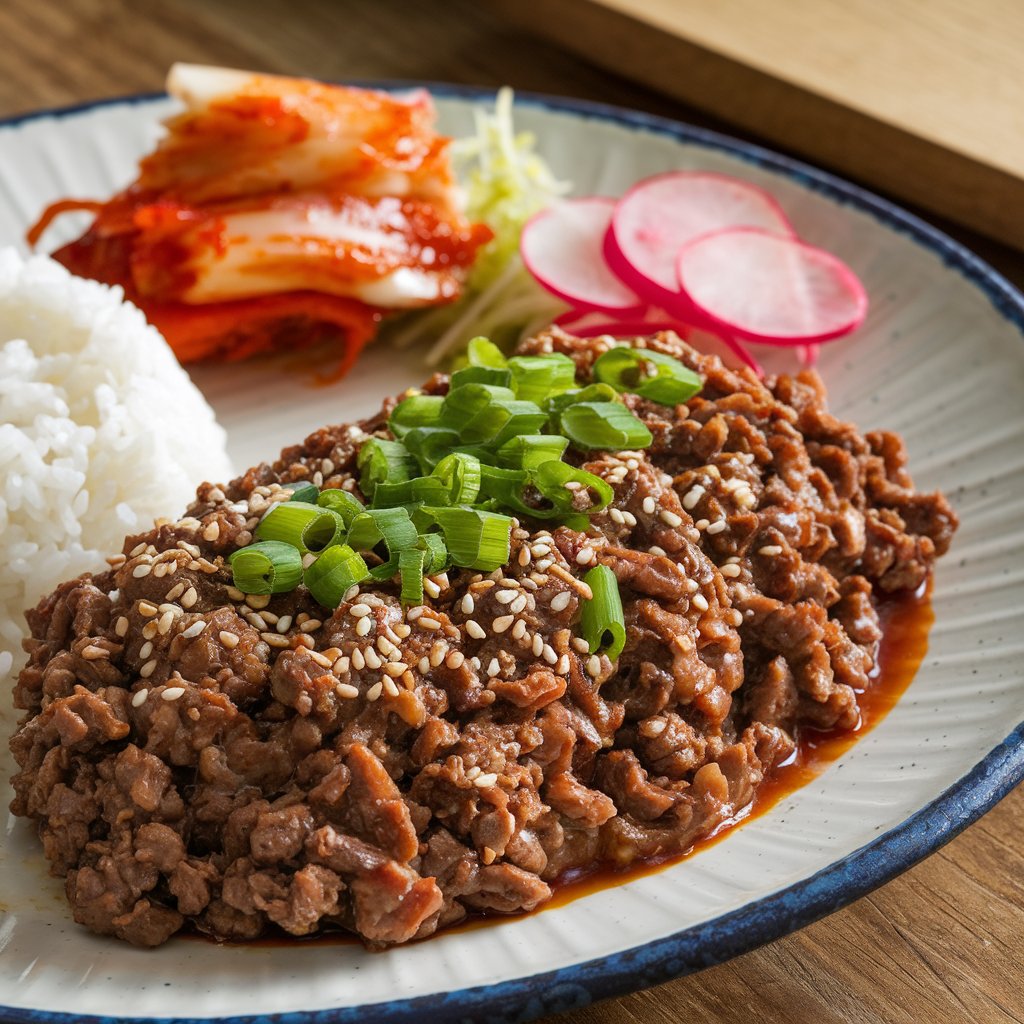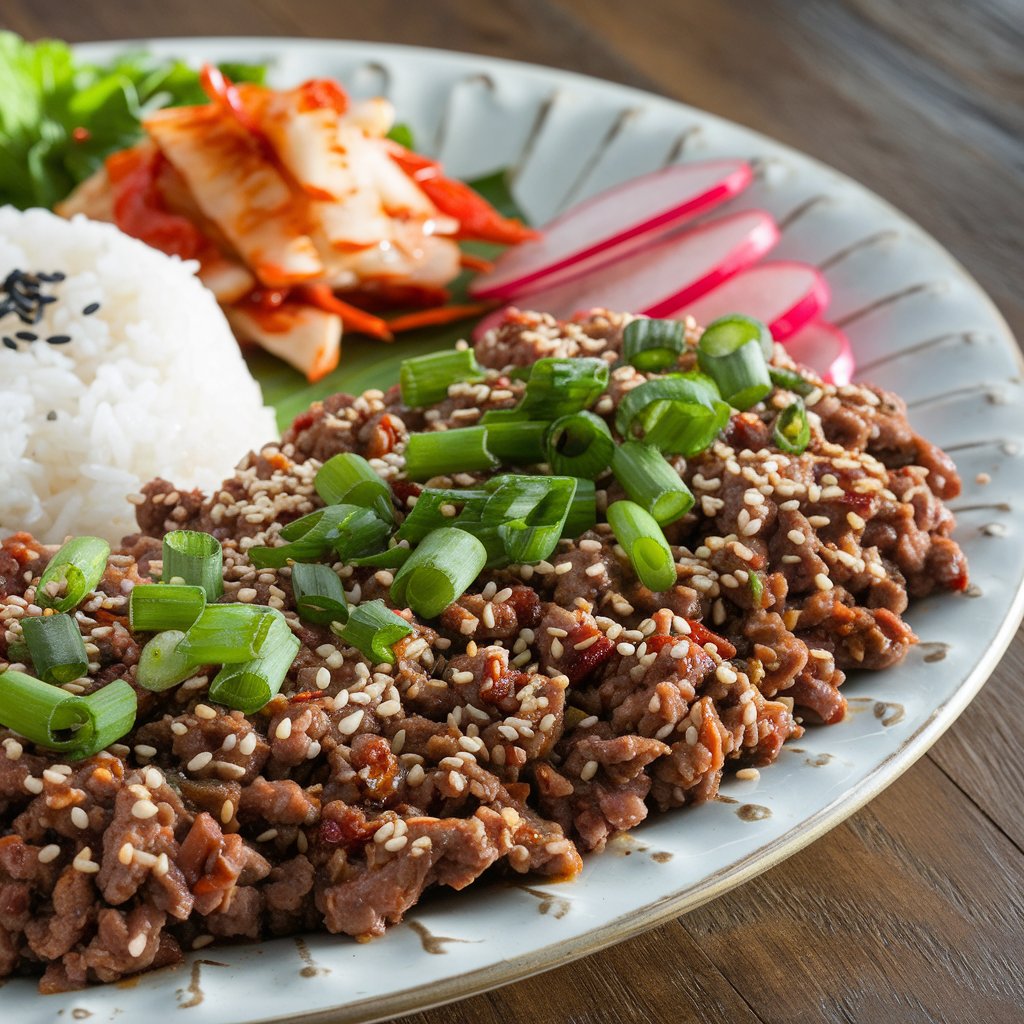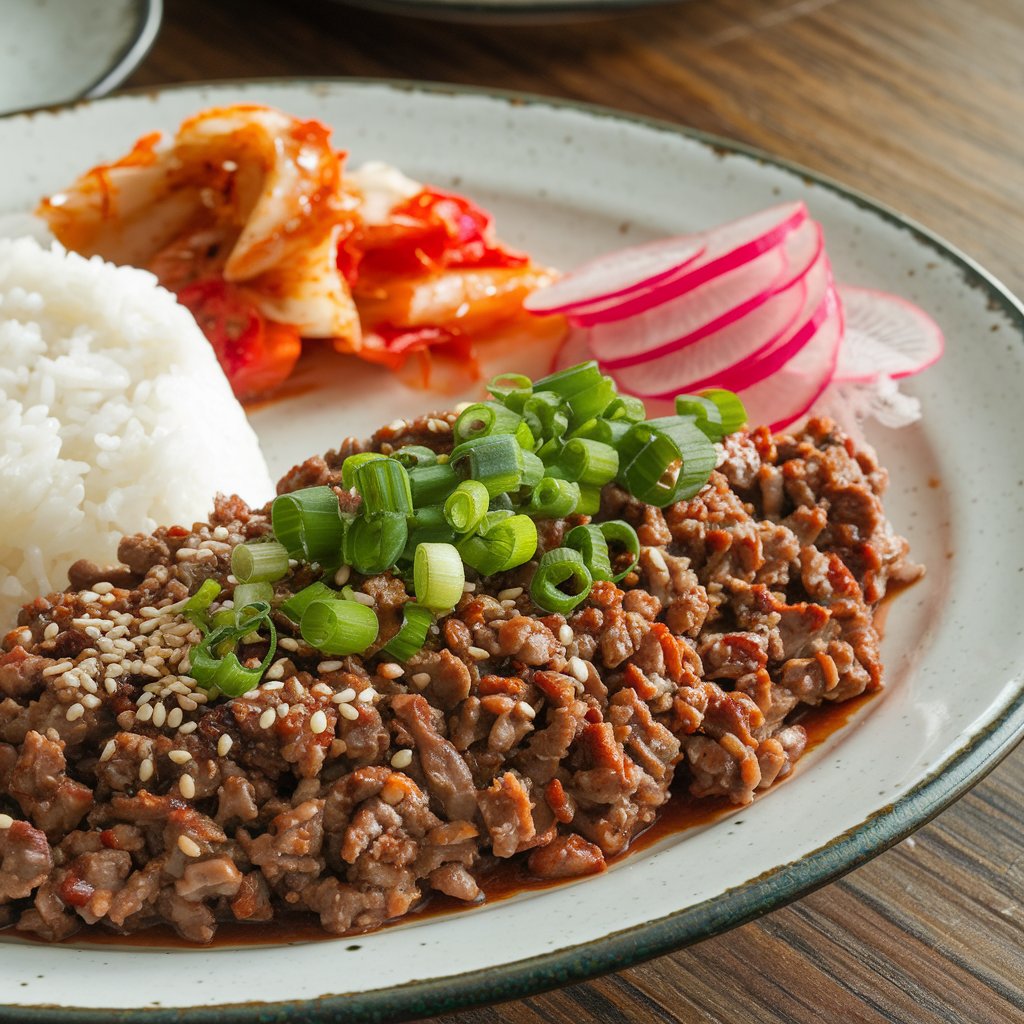Introduction
Table of contents
If you’ve ever craved a dish that’s bursting with flavor yet simple enough to whip up on a busy weeknight, look no further than ground beef bulgogi. This Korean-inspired dish combines sweet, savory, and umami-packed flavors into a satisfying and versatile meal. Unlike traditional bulgogi, which uses thinly sliced beef, this version leans on ground beef for convenience without sacrificing taste. 🍴
Whether you’re a fan of Korean cuisine or just looking for a creative way to use ground beef, this recipe is a must-try. It’s a dish that bridges cultures, bringing bold Korean flavors into your kitchen in an easy-to-make format. Plus, it’s incredibly adaptable—perfect for meal prep, family dinners, or even a casual dinner party.
What is Ground Beef Bulgogi?
Origins of Bulgogi
The term “bulgogi” translates to “fire meat” in Korean, a nod to its traditional preparation over open flames. Originating over a thousand years ago during Korea’s Goguryeo dynasty, bulgogi has long been a staple in Korean cuisine. Traditionally, it features thinly sliced marinated beef cooked quickly at high temperatures. The marinade typically includes soy sauce, sugar, sesame oil, garlic, and other flavorful ingredients that create its signature taste.
How Ground Beef Variants Evolved
Ground beef bulgogi is a modern twist on this classic. By swapping out thinly sliced cuts for ground beef, it becomes a budget-friendly and time-saving option. This adaptation makes the dish more accessible to home cooks without compromising on flavor. Ground beef bulgogi has grown in popularity worldwide, especially in Western countries, as part of the broader trend of incorporating Korean-inspired dishes into everyday cooking.
Ingredients for Ground Beef Bulgogi
Getting the right ingredients is key to achieving that authentic bulgogi flavor. Here’s what you’ll need:
Traditional Ingredients
- Ground beef (1 lb): Choose a lean blend for a healthier dish or one with slightly more fat for added richness.
- Soy sauce (3 tbsp): The base of the marinade, providing depth and saltiness.
- Brown sugar (2 tbsp): Balances out the savory elements with a touch of sweetness.
- Sesame oil (1 tbsp): Adds nuttiness and enhances the aroma.
- Garlic (3 cloves, minced): A must-have for its sharp, savory flavor.
- Ginger (1 tsp, grated): Offers a subtle warmth that complements the marinade.
- Green onions (2, finely chopped): Both a garnish and an integral part of the flavor profile.
Substitutes for Convenience
- Honey or maple syrup: Substitute for brown sugar if you prefer natural sweeteners.
- Tamari or coconut aminos: Gluten-free alternatives to soy sauce.
- Ground turkey or chicken: Lighter options if you want to skip beef altogether.
Unique Add-Ins for Customization
- Chili flakes or gochujang: Add a spicy kick for heat lovers.
- Pineapple juice: For a hint of tang and natural tenderizing properties.
- Shredded carrots or zucchini: Sneak in some veggies for extra nutrition.
Step-by-Step Cooking Instructions
Cooking ground beef bulgogi is straightforward, but a few tricks can elevate your dish to restaurant-quality.
Preparing the Marinade
In a large bowl, mix soy sauce, brown sugar, sesame oil, garlic, and ginger. Whisk until the sugar dissolves completely. This step ensures even distribution of flavors when the beef is added.
Marinating the Beef
Add the ground beef to the bowl, using your hands or a fork to mix gently. Let the beef marinate for at least 15-20 minutes, or refrigerate for up to 2 hours for more intense flavor. Unlike sliced beef, ground beef absorbs the marinade faster, so it doesn’t need to sit overnight.
Pro Tip: Avoid over-mixing the beef to keep the texture tender. 👌

Cooking the Bulgogi
Heat a nonstick skillet or wok over medium-high heat. Add the marinated beef and cook, breaking it up with a wooden spoon or spatula. Let it brown evenly, stirring occasionally to prevent sticking.
A Quick Look at Nutrition
Here’s a snapshot of the nutritional profile of ground beef bulgogi, based on a standard serving:
| Nutrient | Amount per Serving |
|---|---|
| Calories | 350 kcal |
| Protein | 25 g |
| Carbohydrates | 15 g |
| Fat | 18 g |
| Fiber | 2 g |
This dish offers a balanced mix of protein, healthy fats, and carbs, making it both delicious and nutritious.
Serving Ideas, Nutrition, and Troubleshooting Ground Beef Bulgogi
Serving Ideas for Ground Beef Bulgogi
One of the best things about ground beef bulgogi is its versatility. It’s not just a standalone dish—you can pair it with a variety of sides or use it as a base for creative meals. Let’s dive into some serving suggestions that can transform your ground beef bulgogi into a show-stopping meal.
Pairing with Classic Korean Sides
Ground beef bulgogi pairs beautifully with traditional Korean banchan (side dishes). Here are a few must-try combinations:
- Steamed white rice or short-grain brown rice: These neutral bases soak up the bold marinade flavors perfectly. 🍚
- Kimchi: The tangy, spicy fermented cabbage cuts through the richness of the beef.
- Japchae: Sweet potato noodles stir-fried with vegetables are a delightful complement.
- Pickled radishes: Their crunch and slight sweetness add a refreshing element.
Creative Fusion Serving Styles
Why not get a little adventurous? Ground beef bulgogi can easily step outside the boundaries of traditional Korean cuisine:
- Bulgogi Tacos: Wrap the beef in soft tortillas, topped with shredded cabbage, sriracha mayo, and a sprinkle of sesame seeds. 🌮
- Bulgogi Bowls: Layer it over rice, quinoa, or even salad greens for a wholesome meal. Add a fried egg for extra flair! 🥗
- Sliders or Burgers: Turn your bulgogi into patties or use it as a topping for burgers, finished with a drizzle of spicy mayo.
- Lettuce Wraps: Use crisp romaine or butter lettuce leaves for a low-carb option.
Pro Tip: Bulgogi leftovers make fantastic meal prep options—just store them in airtight containers and reheat when needed.

Health and Nutrition Facts
Ground beef bulgogi isn’t just delicious; it can also fit into a healthy diet when prepared thoughtfully. Here’s a breakdown of its nutritional perks:
Nutritional Benefits of Ground Beef Bulgogi
- Protein-Packed: Ground beef is a great source of high-quality protein, essential for muscle repair and growth.
- Rich in Iron: Beef provides heme iron, which is easily absorbed by the body and crucial for energy production.
- Healthy Fats: Using lean ground beef and sesame oil offers a balance of fats that support heart health.
Balancing Flavors and Health
While bulgogi is known for its rich, bold flavors, you can make adjustments to keep it healthy:
- Reduce Sugar: Swap brown sugar for natural alternatives like honey or use half the amount.
- Opt for Leaner Beef: Look for 90% lean ground beef to cut down on saturated fats.
- Boost Vegetables: Incorporate chopped bell peppers, spinach, or mushrooms into the beef as it cooks.
Vegan or Vegetarian Alternatives
If you’re not a meat eater, you can still enjoy the flavors of bulgogi. Try these plant-based swaps:
- Ground tofu or tempeh: These soak up the marinade just as well as ground beef.
- Plant-based meat alternatives: Many brands offer ground “beef” that mimics the texture and flavor of the real thing.
Fun Fact: Adding bulgogi marinade to roasted chickpeas or cauliflower creates a vegan-friendly side dish bursting with flavor. 🌱
Common Problems and Solutions
Like any recipe, ground beef bulgogi can sometimes run into a few hiccups. But don’t worry—I’ve got you covered with solutions to the most common problems.
Beef Overcooking or Burning
- Problem: Ground beef can dry out or burn if cooked at too high a temperature or left unattended.
- Solution: Cook the beef on medium-high heat, stirring occasionally to ensure even browning. Avoid overcrowding the pan, as this can cause steaming instead of searing.
Adjusting Flavors for Picky Eaters
- Problem: The marinade may be too sweet, salty, or bold for some palates.
- Solution: Adjust the marinade before cooking. Add more soy sauce if it’s too sweet, a splash of water if it’s too salty, or a teaspoon of sugar if it lacks sweetness.
Storing Leftovers Effectively
- Problem: Reheated bulgogi can sometimes lose its flavor or become mushy.
- Solution: Store leftovers in an airtight container in the refrigerator for up to 3 days. Reheat gently on the stovetop with a splash of water or soy sauce to refresh the flavors.
Pro Tip: Freeze individual portions for longer storage—just thaw overnight in the fridge before reheating.
FAQ Section
Can I Use Other Types of Meat?
Absolutely! While beef is traditional, you can substitute with ground pork, chicken, or turkey for a different flavor profile. Keep in mind that the fat content will vary, so adjust the cooking time accordingly.
How Long Should I Marinate the Beef?
For ground beef, 15-20 minutes is usually sufficient since it absorbs the marinade quickly. However, if you have time, letting it sit for 1-2 hours can enhance the depth of flavor.
Is Ground Beef Bulgogi Freezer-Friendly?
Yes, it freezes well! Cooked bulgogi can be stored in the freezer for up to 3 months. Just portion it out before freezing for easy thaw-and-serve meals.
Frequently Asked Questions (FAQs)
1. Can I Make Ground Beef Bulgogi Spicy?
Absolutely! Traditional bulgogi leans on sweet and savory flavors, but adding a spicy kick is easy. Simply include:
- Gochujang (Korean red chili paste): Start with a teaspoon and adjust to taste.
- Red pepper flakes: Sprinkle these into the marinade for a gentle heat.
- Sriracha: A handy option if you don’t have traditional Korean ingredients.
2. Can I Cook Ground Beef Bulgogi in Advance?
Yes, ground beef bulgogi is meal-prep-friendly. Cook it ahead and store it in the refrigerator for up to 3 days. Reheat gently on the stovetop or in the microwave, adding a splash of water or soy sauce to refresh the flavors.
3. What Can I Use as a Marinade Substitute?
If you’re missing one or two ingredients for the marinade, here’s how you can substitute:
- Soy sauce: Replace with tamari or coconut aminos for a gluten-free option.
- Sesame oil: Use olive oil or toasted sesame seeds if you’re in a pinch.
- Brown sugar: Honey or maple syrup works well as an alternative.
4. How Do I Avoid Overcrowding the Pan While Cooking?
Overcrowding causes the meat to steam instead of brown, which can compromise flavor. Use a large skillet or cook the beef in batches to ensure each portion gets that perfect sear.
5. Can Ground Beef Bulgogi Be Made Low-Carb?
Yes! Serve it over cauliflower rice or in lettuce wraps for a delicious low-carb meal. You can also reduce the sugar in the marinade or swap it for a keto-friendly sweetener like erythritol.
6. What Side Dishes Can I Pair with Bulgogi for a Complete Meal?
Traditional options include steamed rice, kimchi, and stir-fried vegetables. For a fusion twist, pair it with mashed potatoes, roasted veggies, or even a fresh green salad.
Final Tips for Perfect Ground Beef Bulgogi
To ensure your bulgogi turns out amazing every time, follow these final tips:
- Taste as You Go: The marinade is the heart of this dish, so taste it before adding the beef. Adjust sweetness, saltiness, or spice levels to suit your preferences.
- Don’t Skip the Resting Time: Allowing the beef to marinate—even for 15 minutes—infuses it with bold flavors.
- Cook in a Hot Pan: A well-heated pan ensures the beef caramelizes nicely, which enhances its flavor.
- Garnish for Extra Flavor: A sprinkle of sesame seeds and chopped green onions adds visual appeal and extra taste.
- Get Creative with Leftovers: Use any extra bulgogi in tacos, sandwiches, or even pizza toppings!
Conclusion
Ground beef bulgogi is a true gem of Korean cuisine, offering all the rich, savory flavors of traditional bulgogi in a quick, budget-friendly format. From its deep cultural roots to its adaptability for modern kitchens, it’s a dish that appeals to all palates.
By following this guide, you’ve learned not only how to make ground beef bulgogi step by step but also how to serve it, troubleshoot common issues, and customize it to your taste. Whether it’s a cozy family dinner or a creative fusion experiment, this dish will leave everyone coming back for seconds.
So, roll up your sleeves, gather those simple ingredients, and give this recipe a try. You’re not just making a meal—you’re crafting a culinary experience that bridges tradition and creativity. Bon appétit, or as they say in Korea, 잘 먹겠습니다 (jal meokgetseumnida)—“I’ll eat well!”

